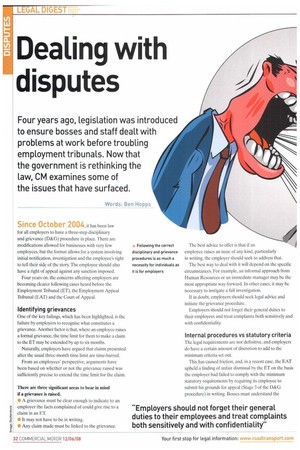Dealing with disputes
Page 32

Page 33

If you've noticed an error in this article please click here to report it so we can fix it.
Four years ago, legislation was introduced to ensure bosses and staff dealt with problems at work before troubling employment tribunals. Now that the government is rethinking the Law, CM examines some of the issues that have surfaced.
Words: Ben Hoops
Since October 2004 it has been law for all employers to have a three-step disciplinary and grievance (D&G) procedure in place. There are modifications allowed for businesses with very few employees, but the format allows for a system involving initial notification, investigation and the employee's right to tell their side of the story. The employee should also have a right of appeal against any sanction imposed.
Four years on, the concerns affecting employers are becoming clearer following cases heard before the Employment Tribunal (ET), the Employment Appeal Tribunal (EAT) and the Court of Appeal.
Identifying grievances One of the key failings, which has been highlighted, is the failure by employers to recognise what constitutes a grievance. Another factor is that, where an employee raises a formal grievance, the time limit for them to make a claim to the ET may be extended by up to six months.
Naturally, employers have argued that claims presented after the usual three-month time limit are time-barred.
From an employees' perspective, arguments have been based on whether or not the grievance raised was sufficiently precise to extend the time limit for the claim.
There are three significant areas to bear in mind if a grievance is raised.
* A grievance must be clear enough to indicate to an employer the facts complained of could give rise to a claim in an ET.
• It may not have to be in writing.
• Any claim made must be linked to the grievance. The best advice to offer is that if an employee raises an issue of any kind, particularly in writing, the employer should seek to address that.
The best way to deal with it will depend on the specific circumstances. For example, an informal approach from Human Resources or an immediate manager may be the most appropriate way forward. In other cases, it may be necessary to instigate, a full investigation.
If in doubt, employers should seek legal advice and initiate the grievance procedure.
Employers should not forget their general duties to their employees and treat complaints both sensitively and with confidentiality.
Internal procedures vs statutory criteria The legal requirements are not definitive, and employers do have a certain amount of discretion to add to the minimum criteria set out.
This has caused friction, and, in a recent case, the EAT upheld a finding of unfair dismissal by the ET on the basis the employer had failed to comply with the minimum statutory requirements by requiring its employee to submit his grounds for appeal (Stage 3 of the D&G procedure) in writing. Bosses must understand the minimum requirements and that any changes within their discretion serve only to increase employees' rights under contractual (as opposed to statutory) D&G procedures.
Applying D&G procedures What happens if employers do not comply with D&G procedures? An EAT decision has confirmed that failure to comply with D&G procedures does not give rise to a claim in itself. There must be some other cause of action.
The usual complaint is unfair dismissal, but a failure to follow D&G procedures, resulting in a dismissal before an employee has 12 months' continuous service, will only be actionable in the ET unless the employee would have accrued 12 months service if not for the failure to follow procedures or the claim is one of discrimination. Ifs not clear what would happen if a claim was based on contractual rights. The employer has a statutory duty to follow procedure, and this may give rise to a claim in the county courts. The employee would not be entitled to a basic award as in the ET, but would have to prove actual loss or damage to recover any compensation.
If the employee has accrued 12 months' continuous employment, or will have done so by the time the D&G procedures would be complete, it is very risky not to follow the procedures. Failure to follow them can make an otherwise fair dismissal automatically unfair. leaving the employer liable to pay compensation. ti
















































































































































































